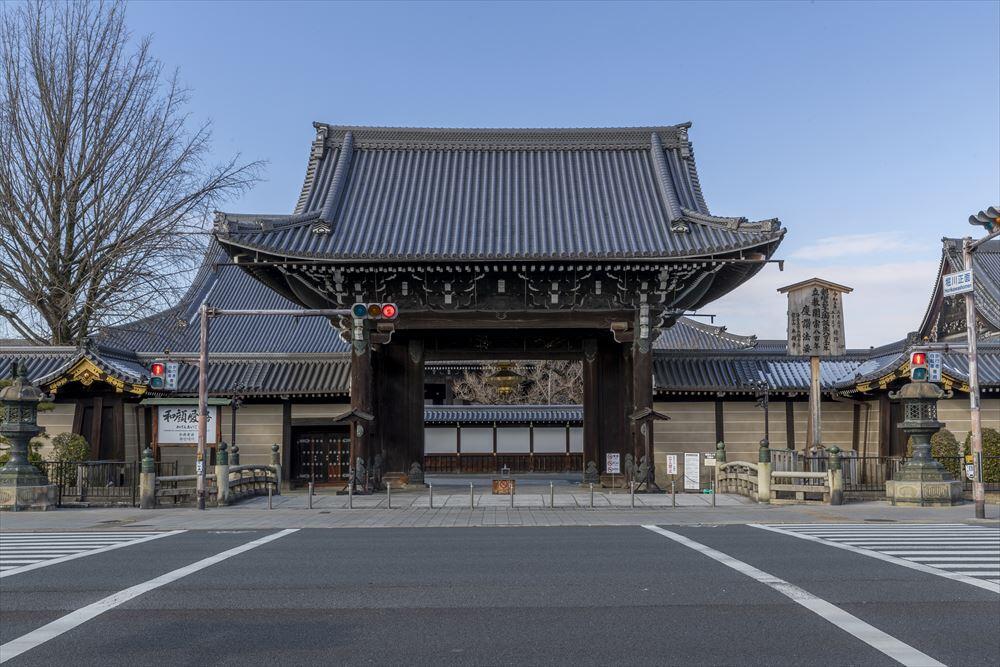音声ガイド_4_御影堂門
4.御影堂門(Goeido Gate)

日本語
御影堂の正面、堀川通に面して建つのが御影堂門です。 建築様式は、入母屋造の本瓦葺で、正面と背面のそれぞれに2本ずつの柱が立つ四脚門です。 江戸時代前期正保2年、1645年の建築で、滋賀県の大津や堅田のご門徒の方たちが工事に協力していたことが記録に残されています。 江戸時代後期の天明8年、1788年の天明の大火の際、阿弥陀堂門は焼失しましたが、御影堂門は類焼を免れました。 門をくぐるとき見上げると、2匹の龍が向かい合って彫刻されています。 平成の修復の際、旧来の彩色が判明したため、龍の目には金箔とプラチナ箔、髭には金箔と、元々の箔が施されました。他にも蟇股に虎や獅子の彫刻が施されています。
中文
4 御影堂門 位於御影堂正面,面向堀川通的大門稱為"御影堂門"。是一座採用了歇山頂式建築風格的瓦屋頂的四腳門。 據記載,御影堂門初建於江戶時代前期的1645年,在滋賀縣大津和堅田的門信徒的協助下建造而成。 江戶時代後期的1788年,京都發生大火災時,阿彌陀堂門被燃為灰燼,而御影堂門當時卻倖免於難。 上樑雕刻有雙目相望的兩條祥龍。 在平成大修復期間,為了重現原有雕刻作品的色彩,對龍眼塗上了金箔和白金,鬍鬚也塗上了金箔。除此以外,上樑處還雕刻著老虎和獅子。
한국어
4 고에이도 문고에이도의 정면 호리카와 도오리 거리에 면해 세워진 것이 고에이도 문입니다. 건축양식은 팔작지붕양식의 기와지붕으로 정면과 뒷면에 각각 2개의 기둥이 세워진 사각문입니다. 에도시대 전반기인1645년에 세워진 것으로 시가현의 오츠와 가타다의 신도들이 공사에 협력했다는 사실이 기록에 남아 있습니다. 에도시대 후기인1788년의 '덴메이노 다이카'라는 대화재 때에 아미다도 문은 소실되었으나 고에이도 문까지는 불길이 옮겨오지 않아 소실을 면했습니다. 문을 지날 때 올려다 보면 2마리의 용이 마주하는 모습이 조각되어 있습니다. 헤이세이 시대에 들어와 복구가 이루어졌을 때 이전부터 사용되었던 채색이 판명되어 용의 눈에는 금박과 백금박, 수염에는 금박 등 원래의 색상으로 복원되었습니다. 그밖에도 개구리가 다리를 벌린 모양을 한 '가에루마타' 라고 불리는 부분에는 호랑이와 사자가 조각되어 있습니다.
English
4 Goeido GateThe gate into the Hongwanji complex which stands in front of the Goeido is the Goeido mon or gate. With two pillars on each side of the gate, it is supported by four pillars. It has been recorded that the construction of the gate took place in 1645 through the efforts of Jodo Shinshu followers who travelled to Kyoto from Otsu and Katata in Shiga prefecture.(slight pause) Looking at the ceiling, is a carving of two dragons facing each other. During recent restorations, the original colors of the carvings were confirmed and so gold and platinum leafing has been applied to parts of the carvings as they were originally decorated when the gate was first built.
Português
4 Goeidô-MonEste portal Goeidô-mon fica à frente do Pavilhão Goeidô, ao lado da Avenida Horikawa-dôri. A arquitetura é de Iriomoya-zukuri, que é composta de quatro pilares e o teto de telhas de barro. Foi construído em mil seiscentos e quarenta e cinco, e escapou do incêndio que destruiu o portal Amidadô-Mon em mil setecentos e oitenta e oito. As esculturas dos dois dragões se encaram na parte superior da porta. Nos adornos de metal estão decorados com esculturas de tigres e leões.


